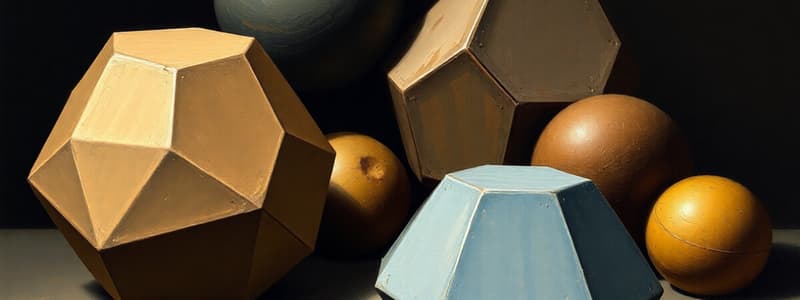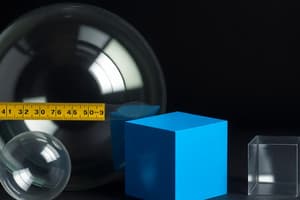Podcast
Questions and Answers
What does Marcus likely mean by the surface area of a cuboid, and how could he calculate it?
What does Marcus likely mean by the surface area of a cuboid, and how could he calculate it?
Marcus refers to the total area of all the faces of the cuboid, which can be calculated using the formula $2(lw + lh + wh)$, where $l$, $w$, and $h$ are the length, width, and height respectively.
How can you calculate the surface area of a cube?
How can you calculate the surface area of a cube?
The surface area of a cube can be calculated using the formula $6s^2$, where $s$ is the length of a side of the cube.
What general rule can be completed regarding the surface area of a 3D shape?
What general rule can be completed regarding the surface area of a 3D shape?
The surface area of a 3D shape is the total area of all its surfaces.
What is the main purpose of sketching nets for different shapes?
What is the main purpose of sketching nets for different shapes?
List two types of simple 3D shapes mentioned in the content.
List two types of simple 3D shapes mentioned in the content.
How many faces does a triangular prism have, and what types are they?
How many faces does a triangular prism have, and what types are they?
What is the minimal number of unit cubes needed to add to create a cuboid from a given shape?
What is the minimal number of unit cubes needed to add to create a cuboid from a given shape?
How can you classify shapes into simple and compound shapes?
How can you classify shapes into simple and compound shapes?
What steps would you follow to draw and create a net for a 3D shape?
What steps would you follow to draw and create a net for a 3D shape?
What is the difference between an open cube and a closed cube?
What is the difference between an open cube and a closed cube?
How do capacity and volume differ, particularly in a culinary context?
How do capacity and volume differ, particularly in a culinary context?
If a shape can be split into a cube and a cuboid, how is it classified?
If a shape can be split into a cube and a cuboid, how is it classified?
Why is it important to understand the relationship between area of 2D shapes and surface area of 3D shapes?
Why is it important to understand the relationship between area of 2D shapes and surface area of 3D shapes?
What is one way to improve a net after assessing its accuracy during folding?
What is one way to improve a net after assessing its accuracy during folding?
What must you keep in mind when sketching a net for a square-based pyramid?
What must you keep in mind when sketching a net for a square-based pyramid?
How many faces does a cube have, and what shapes are they?
How many faces does a cube have, and what shapes are they?
What is the capacity of the jug if it can hold 600 ml?
What is the capacity of the jug if it can hold 600 ml?
If the scale shows the water is at the 500 ml mark, what is the volume of water in the jug?
If the scale shows the water is at the 500 ml mark, what is the volume of water in the jug?
Why is Sofia correct in saying that 2500 ml is equivalent to 2 litres 500 ml or 2.5 litres?
Why is Sofia correct in saying that 2500 ml is equivalent to 2 litres 500 ml or 2.5 litres?
If Marcus thinks the volume of water is 6.1 litres and Arun thinks 6.2 litres, who is correct?
If Marcus thinks the volume of water is 6.1 litres and Arun thinks 6.2 litres, who is correct?
What volume of water must be added to fill a jug to its capacity if 400 ml is currently in the jug with a 1000 ml capacity?
What volume of water must be added to fill a jug to its capacity if 400 ml is currently in the jug with a 1000 ml capacity?
How can Chipo use her measuring jug to measure out 2.3 litres of milk if it measures in millilitres?
How can Chipo use her measuring jug to measure out 2.3 litres of milk if it measures in millilitres?
If Vishan’s fish tank has a capacity of 120 litres and is 3/4 full, what is the volume of water in the tank?
If Vishan’s fish tank has a capacity of 120 litres and is 3/4 full, what is the volume of water in the tank?
In measuring volumes, what method can be used to ensure reading a scale correctly?
In measuring volumes, what method can be used to ensure reading a scale correctly?
How can Mair measure out exactly 400 ml using the available cups?
How can Mair measure out exactly 400 ml using the available cups?
What combination of cups can Mair use to measure 360 ml?
What combination of cups can Mair use to measure 360 ml?
What cups should Mair use to accurately measure 420 ml?
What cups should Mair use to accurately measure 420 ml?
Describe how to get 320 ml using Mair's cups.
Describe how to get 320 ml using Mair's cups.
What is the most effective way for Mair to measure 180 ml?
What is the most effective way for Mair to measure 180 ml?
Which combination of cups measures up to 600 ml?
Which combination of cups measures up to 600 ml?
If jug A has a capacity of 3 litres, how can you create 2 litres with jugs A and B, which has 4 litres capacity?
If jug A has a capacity of 3 litres, how can you create 2 litres with jugs A and B, which has 4 litres capacity?
Can you predict the volumes measurable with jug A (3 litres) and jug B (6 litres)?
Can you predict the volumes measurable with jug A (3 litres) and jug B (6 litres)?
Flashcards are hidden until you start studying
Study Notes
Shapes and Nets
- Compound 3D shapes can be split into simpler 3D shapes
- A cuboid has 6 faces, 4 rectangles and 2 squares
- A cube has 6 square faces
- A square-based pyramid has 5 faces: a square base and 4 triangular faces
- A cylinder has 3 faces: 2 circles and 1 rectangle
- A triangular prism has 5 faces: 2 triangles and 3 rectangles
- A pentagonal prism has 7 faces: 2 pentagons and 5 rectangles
- An octagonal prism has 10 faces: 2 octagons and 8 rectangles
- A hexagonal prism has 8 faces: 2 hexagons and 6 rectangles
- The surface area of a 3D shape is the total area of all of its faces
Capacity and Volume
- Capacity is the maximum amount that a container can hold
- Volume is the amount of space that a substance occupies.
- 1 litre = 1000 ml
- To measure out a specific volume using a measuring jug, you can measure the volume in parts, using different jug sizes
- If a container is three-quarters full, then the volume of the liquid inside is 3/4 of its capacity.
Studying That Suits You
Use AI to generate personalized quizzes and flashcards to suit your learning preferences.




